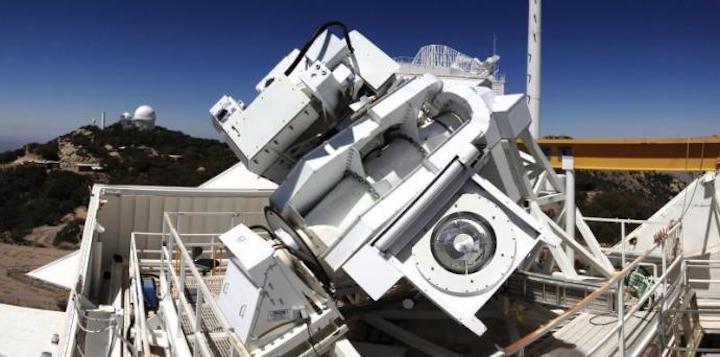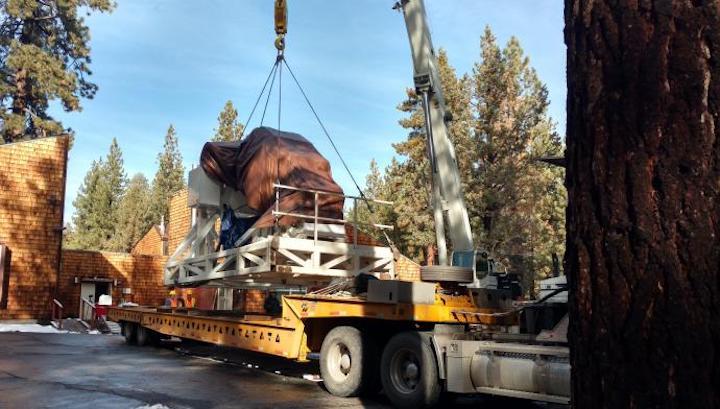2.07.2018

The telescope SOLIS collects images of the Sun over decades, allowing scientists to closely monitor changes.
.
A solar telescope that captures images of the entire disk of the Sun, monitoring eruptions taking place simultaneously in different magnetic fields in both the photosphere and chromosphere, is now being installed beside the Goode Solar Telescope (GST) at NJIT’s California-based Big Bear Solar Observatory (BBSO).
The telescope, SOLIS (Synoptic Optical Long-term Investigations of the Sun), collects images from three separate instruments over years and even decades, rather than minutes or hours, giving scientists a comprehensive view of solar activity such as flares and coronal mass injections over the long-term. It will complement the GST, which gathers high-resolution images of individual explosions at such detail that researchers are beginning to unveil the mechanical operations that trigger them.
“With this important addition, BBSO becomes a comprehensive observing site that offers not only high-resolution solar observations, but also global data of our star,” notes Wenda Cao, an NJIT professor of physics and BBSO’s director. “By monitoring variations in the Sun on a continuing basis for several decades, we will better understand the solar activity cycle, sudden energy releases in the solar atmosphere, fluxes in solar irradiance, or brightness, and their relationship to global change on Earth.”
Earlier this month, BBSO received a $2.3 million grant from the National Science Foundation (NSF) that will fund continuing scientific study of the Sun using the 1.6-meter GST at Big Bear, which is currently the highest resolution solar telescope in the world.
“GST will continue to play a crucial, leading role in advancing solar studies until the end of this decade and beyond. We will obtain, analyze and interpret the highest resolution solar data ever taken, while developing and applying analytical tools to attack a number of critical, leading-edge problems in solar research,” says Cao, the grant’s principal investigator. “This NSF grant is extremely important; it allows us to maintain telescope operations, the current talented engineering team and advanced research at BBSO and on the NJIT campus. Along with other grants, it will provide the vital backbone funding to enable all of the science, instrumentation and education associated with the facility.”
“The addition of SOLIS at the Big Bear Solar Observatory greatly benefits the broader space weather community,” adds Andrew Gerrard, the director of NJIT’s Center for Solar-Terrestrial Research, which operates BBSO, the Owens Valley Solar Array near Big Pine, Calif., the NASA Van Allen Probes RBSPICE instrument, and geospace instruments around the world. “The data from this cluster of instruments will support both space weather forecasts and fundamental solar physics, which provide important components of the 2015 National Space Weather Action Plan.”
SOLIS, which was developed by the National Solar Observatory (NSO), an academic research consortium with backing from the NSF, is moving to Big Bear (below) from its current site in Tucson, Ariz., because the organization is relocating from its facilities in New Mexico and Arizona to new locations in Hawaii and Colorado. Big Bear was deemed an ideal location for SOLIS, because the lake suppresses ground-level atmospheric turbulence caused by heating thermals, offering exceptional “seeing” for long periods per day on its more than 286 sunny days per year.

SOLIS is a suite of three instruments: a vector spectromagnetograph that measures magnetic field strength and direction over the full solar disk within 15 minutes; a full-disk patrol that takes full-disk images of the Sun in various colors at a high cadence; and an integrated sunlight spectrometer that measures minute changes of the spectrum of the Sun as if it were a distant star.
“SOLIS continues a 45-year record of data on the behavior of the Sun’s magnetic field that originally began at Kitt Peak, Arizona. It is also the longest consistent provider of data on the direction of the magnetic field in the photosphere, stretching back to 2003. SOLIS now uniquely provides observations of the strength and direction of the magnetic field in the chromosphere, an important layer of the solar atmosphere where the magnetic field abruptly changes direction from primarily vertical to mostly horizontal,” says Frank Hill, associate director of the NSO.
He added, “This data improves our models of the behavior of the solar corona, particularly when flares occur. The data is also an important input to models of the magnetic field direction inside a coronal mass ejection (CME) when it strikes Earth’s magnetosphere; this is a critical indicator of the strength of the subsequent geomagnetic storm that can adversely affect our technology.”
The variability of the Sun, particularly its cycle of activity, is increasingly important for life on Earth as society becomes ever more dependent on technology in daily life.
Telecommunications, GPS navigation, satellites, space flights with astronauts aboard, airline passengers and the power grid are all vulnerable to damage and disruption caused by solar activity. The Sun is also a driver of Earth’s climate, so its variability needs to be observed. Some aspects of the Sun’s changes are predictable, such as the 11-year sunspot cycle, but the details are not well modeled.
Last year, Haimin Wang, distinguished professor of physics at NJIT, and his colleagues released some of the first detailed views from the GST of the mechanisms that may trigger solar flares, colossal releases of magnetic energy in the Sun’s corona that dispatch energized particles capable of penetrating Earth’s atmosphere within an hour and disrupting orbiting satellites and electronic communications on the ground.
Earlier this year, a team of physicists led by NJIT’s Gregory Fleishman discovered a phenomenon that may begin to untangle what they call “one of the greatest challenges for solar modeling” — determining the physical mechanisms that heat the corona, or upper atmosphere, to 1 million degrees Fahrenheit and higher.
Invisible to the human eye except when it appears briefly as a fiery halo of plasma during a solar eclipse, the corona remains a puzzle even to scientists who study it closely. Beginning 1,300 miles from the star’s surface and extending millions more in every direction, it is more than a hundred times hotter than lower layers much closer to the fusion reactor at the Sun’s core.
Wang said recent technical advances at Big Bear will permit groundbreaking new measurements of the Sun’s magnetism.
“We have developed a way to process GST measurements of the Sun’s magnetic fields using sophisticated software that gives us spectrum profiles of the light emitted by atoms transitioning from one energy state to another. When inverted, these profiles allow us to obtain the strength and direction of magnetic fields,” notes Wang, adding, “Both the BBSO and SOLIS observe the solar chromosphere through the spectrum lines formed by excited hydrogen atoms, which allows us to monitor solar activities such as filaments, sunspots, bright regions of the Sun and flares. But the two instruments capture images of solar structures in different wavelengths.”
An assistant to U.S. Rep. Donald M. Payne, Jr. of New Jersey sent his congratulations on the funding renewal, noting, “Our office is proud of the work you’re doing to help the world better understand our Sun.”
Big Bear is open to scientists around the world, while a third of its observation time is reserved for NJIT researchers and students. Data from SOLIS will be posted on the Internet for all to view. Cao said he expects the telescope to obtain first light this summer.
Quelle: University New Jersey Institute of Technology
